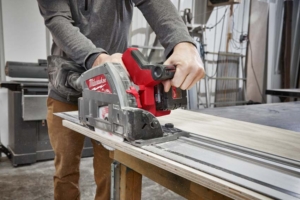As a professional woodworker, I often get asked if a plunge saw can be used as a circular saw. The answer is yes, but it depends on the specific model and the type of cut you are trying to make. Plunge saws and circular saws have similar functions, but there are some key differences that make them better suited for different tasks.
First, let’s define what a plunge saw is. A plunge saw is a type of circular saw that allows you to make precise cuts by plunging the blade into the material. This is different from a traditional circular saw, which requires you to start the cut from the edge of the material. Plunge saws are commonly used for making intricate cuts, such as those needed for joinery or cabinetry. However, they can also be used for straight cuts, which is where the question of whether a plunge saw can be used as a circular saw comes in.
Understanding Plunge and Circular Saws
As a woodworking enthusiast, I have often been asked whether a plunge saw can be used as a circular saw. The answer is yes, but it’s important to understand the differences between the two types of saws and how they are used.
Plunge Saws

A plunge saw, also known as a track saw, is a type of circular saw that is designed to make precise cuts. It has a unique feature that allows the blade to be lowered into the workpiece, which makes it ideal for cutting grooves, dadoes, and other types of joinery.
Plunge saws are often used in combination with a guide rail, which helps to ensure that the cuts are straight and accurate. This is particularly useful when cutting large sheets of material, such as plywood or MDF.
Circular Saws
A circular saw is a versatile tool that is used for a wide range of cutting tasks. It is designed to make quick and efficient cuts through a variety of materials, including wood, metal, and plastic.
Unlike a plunge saw, a circular saw is not designed to make precise cuts. Instead, it is used for rough cutting and general construction tasks. Circular saws are often used in combination with a straight edge or a speed square, which helps to ensure that the cuts are straight and accurate.
Using a Plunge Saw as a Circular Saw
While a plunge saw and a circular saw are different tools, a plunge saw can be used as a circular saw in certain situations. For example, if you need to make a rough cut on a piece of material that is too large to fit on a table saw, a plunge saw can be a good option.
However, it’s important to keep in mind that a plunge saw is not designed for rough cutting tasks. If you need to make precise cuts, it’s best to use a plunge saw in combination with a guide rail.
In conclusion, while a plunge saw can be used as a circular saw, it’s important to understand the differences between the two tools and how they are used. If you need to make precise cuts, a plunge saw with a guide rail is the best option. If you need to make rough cuts, a circular saw is a better choice.
Differences Between Plunge and Circular Saws
When it comes to woodworking, two of the most commonly used saws are the plunge saw and the circular saw. While both of these saws are versatile and can be used for a variety of tasks, there are some key differences between them that are important to understand.
One of the main differences between a plunge saw and a circular saw is the way they are designed to cut. A circular saw is designed to make straight cuts through wood, while a plunge saw is designed to make plunge cuts. This means that a plunge saw can be used to start a cut in the middle of a piece of wood, while a circular saw cannot.
Another key difference between these two saws is the way they are operated. A circular saw is typically operated by holding the saw in place and moving the wood through the blade, while a plunge saw is operated by plunging the blade into the wood and then moving the saw along the cut line.
In addition to these differences, there are also some differences in the types of blades that are used with these saws. Plunge saws typically use blades with fewer teeth than circular saws, which allows them to make faster cuts. However, circular saws are better suited for cutting through thicker pieces of wood.
Overall, while both plunge saws and circular saws are useful tools for woodworking, they are designed for different types of cuts and are operated in different ways. Understanding these differences can help you choose the right tool for the job and ensure that you get the best results possible.
How to Use a Plunge Saw as a Circular Saw
Safety Measures
Before using a plunge saw as a circular saw, it is important to take the necessary safety measures to avoid accidents. Here are some safety measures to consider:
- Wear appropriate safety gear such as safety glasses and ear protection.
- Make sure the plunge saw is unplugged before changing the blade or making any adjustments.
- Ensure the blade is sharp and properly installed.
- Keep your fingers away from the blade and avoid wearing loose clothing or jewelry that could get caught in the blade.
- Always use the plunge saw on a stable surface and never force the saw through the material.
Procedure
Here are the steps to follow when using a plunge saw as a circular saw:
- Adjust the depth of the blade to the appropriate depth for the material you will be cutting. This can be done by loosening the depth stop and adjusting it to the desired depth.
- Set the plunge saw on the material and align the blade with the cutting line.
- Start the plunge saw and slowly plunge the blade into the material until it reaches the desired depth.
- Hold the plunge saw firmly and guide it along the cutting line.
- Once you have finished cutting, release the plunge lock and lift the saw out of the material.
Using a plunge saw as a circular saw can be a useful technique when you need to make precise cuts. However, it is important to follow the safety measures and procedure to avoid accidents and achieve the best results.
Benefits of Using Plunge Saw as a Circular Saw
As a professional woodworker, I often get asked if a plunge saw can be used as a circular saw. The answer is yes, and there are several benefits to doing so.
Firstly, plunge saws provide more precision and accuracy than traditional circular saws. The ability to plunge the blade into the material allows for cleaner and more accurate cuts, especially when cutting at an angle or making intricate cuts.
Another benefit is that plunge saws are typically more powerful than circular saws, which means they can handle thicker and harder materials with ease. This makes them an excellent choice for heavy-duty cutting tasks.
Plunge saws also offer greater safety features than circular saws. The plunge mechanism keeps the blade hidden until it is engaged, reducing the risk of injury. Additionally, many plunge saws come with built-in dust collection systems, which help keep the work area clean and reduce the risk of respiratory issues.
Finally, plunge saws are more versatile than circular saws, as they can be used for both plunge and non-plunge cuts. This means that you can use one tool for all of your cutting needs, rather than having to purchase separate tools for different tasks.
In conclusion, using a plunge saw as a circular saw has several benefits, including increased precision, power, safety, and versatility. As a professional woodworker, I highly recommend investing in a plunge saw for all of your cutting needs.
Limitations and Risks
As with any power tool, using a plunge saw as a circular saw comes with its limitations and risks. Here are a few things to keep in mind:
- Depth of cut: A plunge saw is designed to cut through thicker materials, whereas a circular saw is better suited for thinner materials. Attempting to use a plunge saw to make shallow cuts may result in a less precise cut or damage to the material.
- Blade size: Plunge saws typically have smaller blades than circular saws, which can limit the size of the material being cut. Attempting to use a plunge saw to cut through thicker materials may result in a slower cut or damage to the blade.
- Safety: Plunge saws are designed with safety features such as blade guards and safety switches. Attempting to use a plunge saw as a circular saw may result in a higher risk of injury if these safety features are not used properly.
It’s important to note that while a plunge saw can be used as a circular saw, it may not always be the best tool for the job. It’s important to assess the material being cut and choose the appropriate tool for the task at hand.
check out also
can a circular saw replace a table saw
Conclusion
In conclusion, a plunge saw can be used as a circular saw, but with some limitations. Plunge saws are designed for making precise plunge cuts, while circular saws are designed for making straight cuts through thicker materials.
When using a plunge saw as a circular saw, it may not be able to make cuts as quickly or efficiently as a circular saw, especially when cutting thicker materials. Additionally, plunge saws may not be as durable as circular saws, which are built to withstand heavy use and abuse on construction sites.
However, if you already own a plunge saw and need to make straight cuts through thinner materials, such as plywood or MDF, it can be a useful tool to have in your arsenal. Just be sure to use the proper blade for the job and take extra care when making cuts to ensure accuracy.
Overall, while a plunge saw can be used as a circular saw in some situations, it is not a replacement for a dedicated circular saw when it comes to making straight cuts through thicker materials.

Reader Interactions